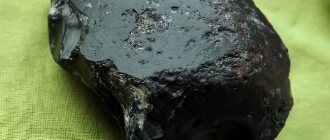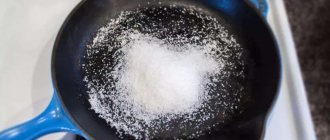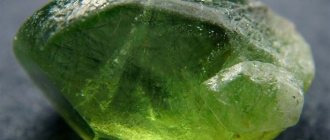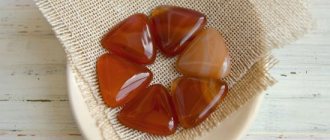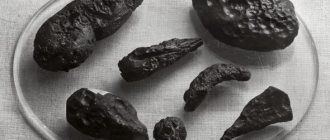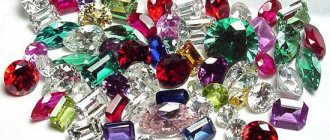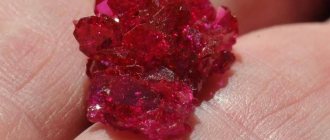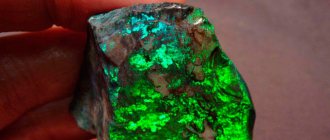Origin of obsidian
The formation of rock is associated with the eruption of molten magma and rapid cooling when encountering layers of ice or water. The composition and temperature of the lava and the cooling rate are of decisive importance for the appearance of volcanic glass. Stone is formed when molten rocks do not have time to crystallize due to rapid cooling. Most of the known deposits arose during the Pliocene period 2–4 million years ago. Obsidian finds are no older than the Cenozoic era (new life), which has been going on for 65 million years.
Obsidian
Volcanic origin, strong shine, deep black color make the rock special. The modern scientific name, according to one version, is not related to its origin or color. The name comes from the name Obsius. This was the name of the Roman commander who was the first to bring samples of the mineral from Ethiopia to Rome.
The chip of the stone is sharp, it itself is relatively hard, but can be easily processed. In ancient Greece and Rome, black varieties of the breed were associated with the dead and the afterlife. Only in the Bronze and Iron Ages did lava glass become more widely used to decorate the interiors of palaces, temples and tombs.
Obsidian products and jewelry
Obsidian bracelet
Decorative items made from volcanic glass always look noble and a little solemn. The stone is highly polished. Boxes, photo frames, vases will add a touch of aristocracy to the interior of the house. An obsidian souvenir - what could be better as a gift for a loved one.
Bracelets, beads, rings, and earrings are also made from obsidian. Due to its original appearance, the stone matches clothes of any color, both bright and plain.
The cost of obsidian depends on several factors:
- stone colors;
- its size;
- cutting;
- forms;
- processing difficulties.
The price for 1 gram of obsidian is low, it starts from $1. But there is a rarest type of stone - green obsidian, the cost of which is higher than that of a diamond.
Approximate cost of volcanic glass products:
- Beads - from $20.
- Earrings, rings - $40.
- Bracelets - $15.
- Pendants, amulets - $2.
- Small spheres, figurines - $20.
Place of extraction
Obsidian is often found in areas of ancient and modern volcanism. The main production regions are the USA, Canada, Mexico, Chile, Peru, Guatemala. In the Eastern Hemisphere - in Japan, Indonesia, on the island of Java, in Russia in Kamchatka and in the Kuril Ridge region.
Other deposits:
- European countries (Iceland, Italy, Greece, Slovakia, Germany, Spain).
- The foot of Mount Ararat in Turkey.
- Lake Sevan region in Armenia.
- Canary Islands.
- Easter Island.
Since volcanism was active in ancient times and has not disappeared now, the conditions for the formation of rock remain. Obsidian reserves are considered virtually inexhaustible. The stone is common and is not considered precious or semi-precious. Unusual varieties are prized.
Reserves of red obsidian have been explored in Mexico. The golden specimens found in the same region have no analogues in the world. Rarely do you come across minerals with a matte tint. Unusual specimens and typical lava glass are used to create jewelry and interior items.
Lava glass is not a precious mineral.
Physicochemical characteristics
Volcanic rock ranks in the middle of the natural mineral hardness (Mohs) scale. The value is in the range of 5–6 units. Obsidian is a fragile stone; when struck, it breaks into fragments that have a pointed shape and very sharp edges. Wear resistance is low.
Physical properties:
| Property | Description |
| Color | Black, gray, less often - dark red, brown, golden |
| Transparency | Transparent or opaque |
| Shine | Glass, strong; there are matte varieties |
| Average density | 2.5 g/cm3 |
| Medium hardness | 5,5 |
| Melting temperature | 1200–1500°С |
| Electrical conductivity | Insulator |
| Radioactivity | Not radioactive |
The basis of the rock is volcanic glass, consisting of silicon dioxide. The silica content is 66–75%. There are oxides of alkali and alkaline earth metals. The dark color is due to the presence of magnesium and iron oxides. Within the clear areas of the volcanic glass, darker “tongues” can be seen, as if day meets night.
Obsidian chemically belongs to the rhyolite family. This is the name given to natural silicas with a high SiO2 content. There are inclusions of alkali feldspar and andesite.
Obsidian with inclusions.
Varieties and colors
It is very rare to find completely transparent obsidian. Typically, samples are translucent and contain more and less dark areas.
Obsidian stone color and rock meaning:
- Black is the most common and owes its color to the high content of magnetite and hematite.
- Snowy is a black or dark brown stone with white inclusions that resemble snowflakes in appearance.
- Brown is also a common stone color. It is believed that it brings harmony to life and promotes spiritual growth.
- Rainbow is a very rare stone with colored tints and stains (like gasoline in a puddle).
- Green - with a predominance of shades of olive or dark green.
- Silver is a rare variety, “the stone of spirits, sages, magicians.”
- Golden - brownish color with a metallic sheen.
- Peanut - multi-colored, resembles a nut when cut.
- Californian - has a blue color.
Peanut mineral.
In some cases, the stone takes on reddish or purple hues. They occur when impurities of other rocks enter the molten magma, which cannot come out and crystallize. Unusual varieties are credited with special magical and therapeutic powers.
Notes
- Description of obsidian - Catalog of minerals
- [1] — All about geology, Moscow State University.
- For example, Hofmann, Johann Jacob (1635-1706) in his dictionary “Lexicon Universale”.
- Buck, B. A. (March 1982). "Ancient Technology in Contemporary Surgery". The Western journal of medicine 136
(3): 265–269. PMID 7046256.
To improve this article it is desirable:
|
Medicinal properties
In lithotherapy manuals published in different countries, obsidian is mentioned as one of the most important healing stones among more than 400 rocks and minerals. Reviews are devoted to the influence of physical and chemical characteristics, origin on the therapeutic effect, and significance for the signs of the Zodiac. Modern lithotherapists claim that obsidian can alleviate the course of diseases and speed up recovery.
The value of the stone for health:
- has a beneficial effect on the functioning of the gastrointestinal tract and liver;
- stabilizes blood pressure and kidney function;
- used in hematology, for long-term non-healing wounds;
- helps improve metabolism and strengthen the immune system;
- used for nervous disorders and increased anxiety.
Snow obsidian helps improve metabolism.
Thanks to the therapeutic effect of the stone, erosions and ulcers heal faster and the absorption of nutrients improves. When wearing an obsidian bracelet on the left hand, vascular tone and blood pressure are normalized. The energy of volcanic glass helps restore the body after heart attacks and strokes.
Obsidian can be used for deep emotional upheavals and experiences that cause emotional pain. The stone gives strength and supports in confronting troubles. It also helps to find resources for an active life in one’s own body, and helps to learn useful lessons from traumatic situations.
Obsidian stone relieves depression.
Black volcanic glass helps to get rid of various phobias. Helps to cope with past negative experiences and associated mental and physical pain. Internal unused reserves are revealed and perception increases.
It should be noted that the information about the healing properties of stones given in reference books and encyclopedias on lithotherapy is based on folklore sources and publications on traditional medicine of past centuries. Information about the healing effects of rocks and minerals has not been tested in clinical studies. This is the result of centuries-old observations and application experience.
The mysterious history of the origin of the mineral
The obsidian mineral has a complicated history of origin, full of mysteries and secrets. It seems that the path of the amazing stone is as long as the entire history of mankind. For the first time, effusive rock was mentioned in the records of the ancient Greek scientist Theophastus, who lived in the 3rd-4th centuries. BC e. However, numerous archaeological excavations confirm the fact that obsidian was actively used back in the Stone Age.
The stone of volcanic origin received its official name in honor of the Greek warrior Obsidia. It was he who first appreciated the beauty of minerals and brought them to Rome. Our ancient ancestors believed in the amazing magical properties of the stone. It was often used to create various talismans and ritual knives.
There are different versions explaining the origin of the mysterious mineral:
Residents of Hungary do not put forward their own versions regarding the origin of the mineral. But they gave the stone an interesting name: luxury sapphire. The Hungarians explain such an unusual name by the fact that volcanic glass is strikingly similar to a precious stone. They are united by a mysterious shine, shimmer and mysterious glow.
The magical properties of obsidian
The greatest civilizations of antiquity - the Aztecs and Mayans - revered lava glass and performed magical rituals with it. According to Aztec beliefs, Mother Earth created the moon and stars using a blade of shiny black stone. The Indians poured molten obsidian over the mirror and examined its drips and reflections. The "Smoking Mirror" was a symbol of the powerful god of the night, war and witchcraft. He wore an obsidian robe that allowed him to see people's hearts and "read" the future.
According to one of the myths of the Indians of North America, the gods created the hearts of people with the help of the “Nevada diamond”. In Central America, Indians created obsidian-like swords to fight conquistadors. The appearance of the name “Tear of the Apaches” is also associated with wars of conquest in the New World.
There are legends that obsidian is the claw of Satan himself.
Another myth says that the devil broke off his claws, and they are still found by seekers. Another legend says that Cain killed Abel with a volcanic stone. Later, Christians recognized this breed as a symbol of truth, wisdom, and the rapprochement of the Higher Mind and Matter. According to beliefs, the magic of obsidian stone is aimed at protecting against negative emotions and healing the soul.
Sharp cuts of stone were used in ancient times during various rituals associated with blood and sacrifices. Modern Mexican witches carry pieces of black volcanic glass with them to protect themselves from the “evil eye” and ward off evil spirits.
Talismans and amulets
Volcanic glass makes its owner luckier and more attractive in the eyes of others. Interestingly, thanks to the magical properties of obsidian, the owner of the raw mineral or a product made from it also becomes more attentive and sensitive to other people. The stone seems to make it possible to move faster in spiritual development, seek and find inspiration, and receive “flashes” of insight.
According to Eastern beliefs, lava glass reveals to the wearer the secrets of his previous incarnations and helps reduce the severity of karmic “traumas”. Meditation with a stone allows you to quickly overcome existing psychological complexes and mental problems. In a number of countries, magic balls are made from volcanic rock.
Obsidian can be considered a talisman, an amulet, and a talisman. He is able to suppress aggression and relieve tension.
Married couples can wear obsidian wedding rings to maintain fidelity and harmony, romance and passion in family life. If jewelry and objects for rituals belong to psychics and magicians, then it is easier for them to “communicate” with higher powers. Obsidian also helps clairvoyants develop the ability to see the past and future.
Healing properties of magic stone
The mineral, whose amazing power has been known to more than one generation of people, is valued not only for its magical qualities. It is widely used in folk medicine as a magical remedy for various ailments.
It is advisable to wear the talisman near the organ that needs help. For example, if a person wants to treat his eyes or respiratory system, he can purchase earrings with obsidian inserts. To treat heart diseases, it is recommended to decorate yourself with beads. Jewelry with this wonderful mineral can be worn not only to get rid of existing ailments. They are also used for preventive purposes.
Surprisingly, obsidian has also been used in traditional medicine. Instruments made from this material are used by certified surgeons during operations.
Who is suitable according to their zodiac sign?
According to astrologers, it is useful for Aquarius, Taurus, Gemini, and Sagittarius to keep obsidian with them. People born under these signs will become more successful, decisive, but with a reasonable amount of caution. The energy of volcanic rock is suitable for them because it helps in the implementation of plans and in achieving success in their chosen field.
Lava stone is not desirable for Aries, Virgos and Cancers. These signs can become too dreamy and detached from reality. Such changes will not benefit a person either at work or at home.
Scorpios in different ways Obsidian will help a shy person feel more confident and become bolder. The stone can make overly self-confident people selfish and cynical.
Capricorns more of what they strive for all their lives, in accordance with their horoscope - stability, balance. For Libra, the mineral helps solve problems associated with the realization of hidden desires. Obsidian is neutral in relation to other signs.
Compatibility with other stones and names
Combinations of rocks and minerals are a controversial section of magic, lithotherapy, and astrology. As criteria, you can choose the subordination of one element, the control of the planets. If the alignment is incorrect, negative vibrations are possible.
Obsidian is a stone belonging to the element of Earth.
Its combinations with agate, onyx, jasper, amber, and malachite are favorable. Other “buddies” of volcanic rock: jade, turquoise, emerald, jet, aventurine. Lava glass feels good next to Fire minerals - garnet, hematite, topaz, tiger's eye, carnelian, red agate, diamond. Great combination with rock crystal. The stones enhance each other's energy. Not compatible with ruby.
Earrings with obsidian and rock crystal.
Obsidian is more suitable for Tatyans, Darias, Natalias, and Maxims. The stone helps people bearing these names choose the right path and avoid unwanted deviations from it. Volcanic glass also suits the name Ilya. Obsidian gives a man with this name energy and strength to withstand adversity and adapt to changes in life.
Stone cost
The price of the stone is relatively low. It depends on the place of extraction, type of stone, size. For example, a keychain in the shape of a pear made of snow obsidian mined in the USA can be bought for 300 rubles, a pendant in the shape of a fang made of a brown mineral 4.5 cm long, brought from Armenia, for 390 rubles.
Silver earrings with black Mexican obsidian will cost about 5,500 rubles, a brooch made of a silver stone measuring 6.5 x 2.5 cm, weighing 28 grams, framed in genuine leather, will cost 6,200 rubles. Snow obsidian beads from the USA, 47 cm long, assembled from faceted beads with a diameter of 10 mm, cost 3,700 rubles.
Obsidian is a stone with a long history that has been used in many areas. Jewelry with the mineral will make the owner more self-confident, give him a weighty appearance, and help maintain health.
Which theory do you think is most likely about the origin of the name of the stone? Do you or someone you know have obsidian jewelry? Share this article with your friends, it may be useful.
Where is it used
The first people found volcanic glass near their sites, because in ancient times eruptions were frequent. Together with flint, obsidian became one of the first natural materials that was processed to produce simple tools and weapons (knives, arrows, spears). Women used pieces of shiny polished stone as a mirror.
Processed obsidian was used in surgery and was highly valued in the manufacture of jewelry and art objects. During the time of the masters of the Faberge jewelry house, the mineral was “rediscovered” for the high society of Europe. The “obsidian boom” began - increased interest in jewelry made from this stone. Subsequently, the windy fashion changed direction.
Obsidian is still used as an ornamental material. Jewelry is made from it. Bracelets, pendants, inserts in rings and earrings, and beads look great. The interior is decorated with animal figures and pyramids made of volcanic glass. Rosary beads and obsidian chess pieces look impressive.
Volcanic glass chess.
Mineral cost
Ornamental stones are inexpensive because they are not rare. The price for 1 kg of obsidian is 50 rubles. The rarest varieties, of which there are few, are more expensive. For example, the price for 1 g of rainbow stone is from 500 to 800 rubles.
Green, golden, ruby volcanic glass is close to precious stones in value. In many ways, the price depends on the deposit and the volume of processing that was required after mining the rock.
Areas of application
Obsidian tools from Tilkitepe, Turkey, 5th millennium BC.
e. The use of the mineral is possible in various fields. However, most often it is used as an ornamental stone. Before starting to create beautiful products, the mineral is carefully polished. It acquires a smooth surface and a special shine.
The stone is often used to create inexpensive jewelry. Obsidian earrings, bracelets and beads are perfect for daily wear. They are especially suitable for dark-eyed brunettes and emphasize the natural beauty of their owner.
Black glass is also used to create interior items: bowls, glasses, vases. Obsidian rosary beads look unusual.
This amazing mineral is incredibly popular in the fields of jewelry and applied arts. Works by famous sculptors and jewelers, which contain elements of volcanic glass, can still be found in various museums around the world. Carl Faberge especially appreciated the unique properties of obsidian. He used the mineral in his works, which are now famous throughout the world.
The main area of application for obsidian is construction. It is from obsidian that perlite is obtained, a building material with excellent thermal insulation properties.
Due to the ability of obsidian powder mixed with slaked lime to harden under water, it is used as a hydraulic additive for Portland cement. It is also used as an additive to lime, as a raw material for the production of dark glass and as thermal insulation.
Obsidian blades have a smooth edge just a few nanometers thick, allowing them to be used as scalpels.
How to distinguish from a fake
Fake obsidian is black or dark green glass. It is easier for specialists than for ordinary consumers to distinguish natural stone from artificial and synthetic ones. It is necessary to pay attention to whether there is a “magical” shine of natural volcanic glass, especially noticeable in the sun.
Real obsidian has a deep, rich color. In some places the stone is translucent. If you hold it in your palm, it does not heat up for longer compared to synthetic materials. An easy way to check the authenticity of obsidian is to briefly place it in water (2-3 minutes). The color of the stone will change, and if you quickly wipe it dry, the original color will return. You also need to pay attention to the price. Genuine obsidian, especially its rare varieties, cannot be cheap.
How to care
Obsidian is cleaned every four weeks - rinsed briefly under running water. The stone is charged in the sun or placed next to rock crystals. It is better to store separately from other jewelry. Handle volcanic rock and products made from it carefully so as not to damage it. The fragments are very sharp, you can cut yourself with them.. You should not wear it too often - obsidian fades from contact with damp skin and the sun.
The volcanic rock appeared in ancient times during the eruption and rapid solidification of magma. Since then, black or other colored obsidian has been found near active and extinct volcanoes. Lava stone can make anyone who touches it fall in love with it. But volcanic glass must be handled with care, both as a magical object and as a decoration.
